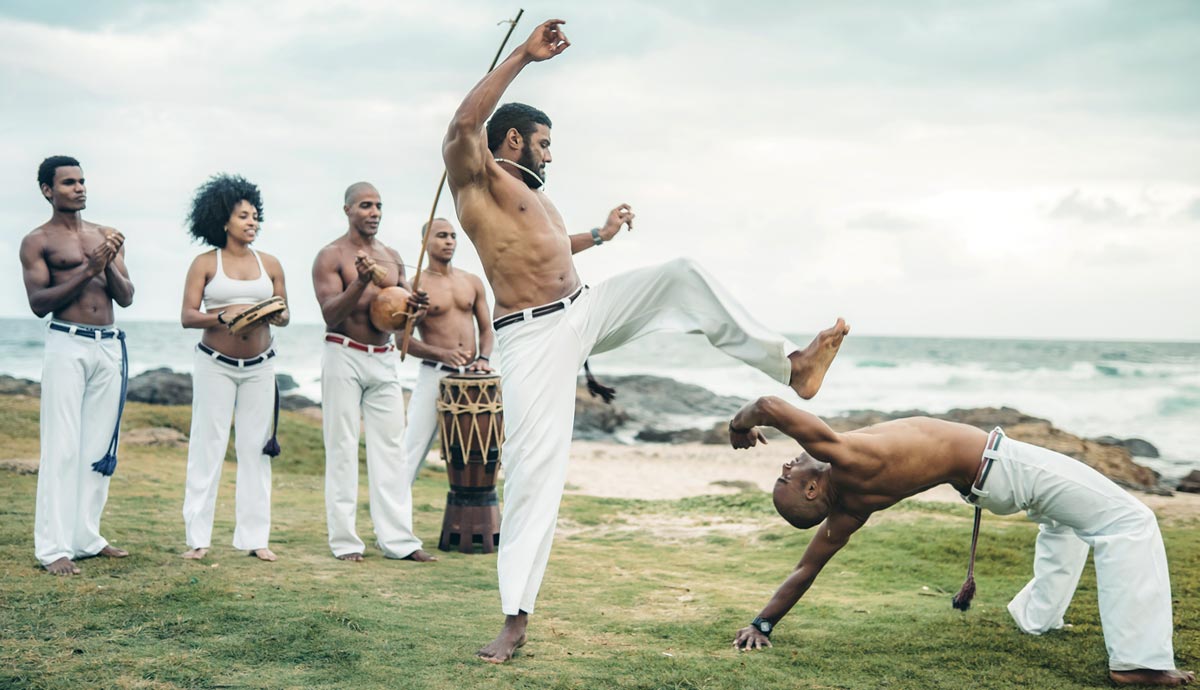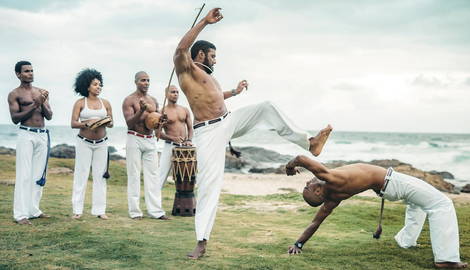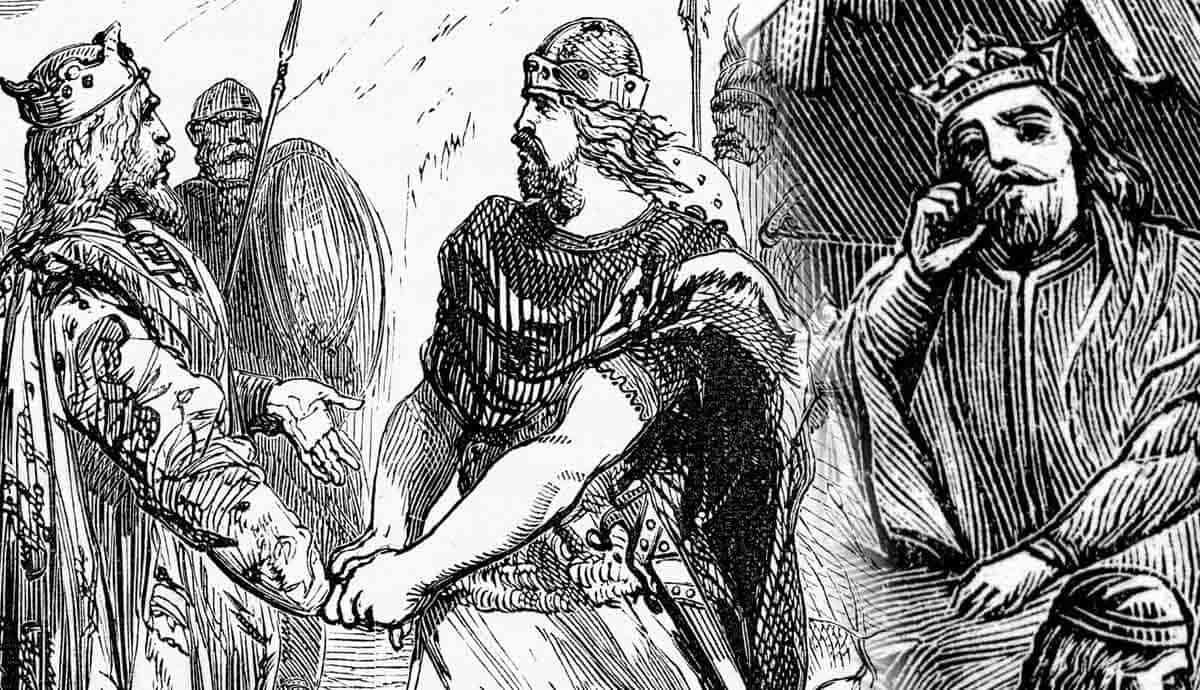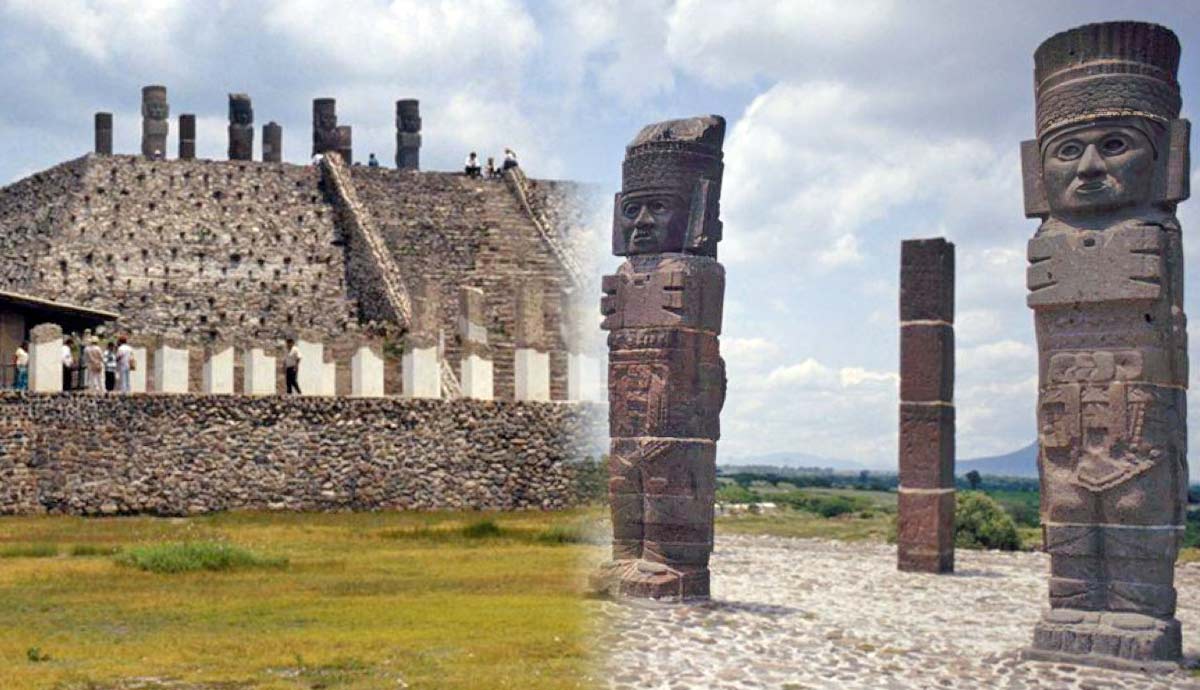
If you have ever been to Brazil, then you have probably seen Capoeira played in its streets. It happens within a circle of people who play instruments, sing, and clap while the two contenders engage in what looks like both a fight and a dance.
Capoeira was created by Africans transported to Brazil to work as slaves. They mixed fight, dance, and musical traditions from their various countries to create something uniquely Brazilian.
Capoeira is a fight that was disguised as a dance so that overseers would not quash this act of defiance. It came to represent freedom and resistance in the Quilombos of Brazil and is now a powerful vehicle for sharing Brazilian culture around the world.
African Origins of Capoeira

The Portuguese took control of what is now Brazil at the end of the 15th century. Sugarcane plantations thrived and soon became the principal export of the new colony. But the colonizers needed lots of cheap labor to work the farms. They initially tried to enslave the Brazilian natives, but this turned out to be a bloody and unsuccessful endeavor. Instead, they looked to the African slave trade.
Between the 1540s and the 1860s, around 5.5 million Africans were transported to Brazil as forced labor. They were mainly from three ethnic groups, the Bantu, the Yoruba, and the Fons, from countries corresponding to modern-day Angola, Congo, Democratic Republic of Congo, Mozambique, Togo, Benin, and Nigeria.
The Africans brought with them different languages, religions, and cultural traditions. What they had in common was their situation as oppressed people in a foreign land. While returning to their African homes seemed like an increasingly unrealistic dream, fighting for freedom in the New World was not.
This diverse group of Africans came together while working in engenhos (sugarcane plantations) and shared their knowledge of how to defend themselves. They would find flat areas of vegetation on the plantations or in the forest and train together. These areas were known in the native Brazilian language Tupi as ka’a pau—and it is thought to be the origin of the name Capoeira.
Since it was necessary to hide their activities from slavers, Africans disguised their martial arts training as a dance. They would play music and clap while their comrades were engaged in practice fights. If someone was watching, the fighters would transform their movement into a dance.
Capoeira was principally created in Bahia, around Salvador, and the Recôncavo, home to major port cities. But Capoeira quickly spread throughout Brazil.
What is Capoeira?

The main principle of Capoeira is that it is a fight disguised as a dance. The two players move their bodies in a fluid dancing motion to music. But while they may look like they are dancing, they are also trying to trick their opponent into opening their defenses so that they can apply an attack (golpe). The art of trickery in Capoeira is called malandragem.
Acrobatic moves are also fundamental to Capoeira, and the au (cartwheel) is one of the first moves that new capoeiristas learn. These moves are both part of the dance and can be applied as versatile attacks. Learning these moves is also fundamental to learning the agility required to play Capoeira.
You play (joga) Capoeira rather than fight (luta), and the game is overseen by a bateria (percussion band) of instruments. The composition of the bateria depends on a variety of factors, but it always has at least one berimbau. This is a single-string percussion instrument that looks like a bow with a gourd attached.
The berimbau is accompanied by different percussion instruments including pandeiros (a type of tambourine) atabaques (a type of hand drum) and clapping from the group that forms an enclosed circle around the two players called the Roda (wheel). This closing of the circle focuses both the music and the energy of all the participants into the Roda and towards the players.
The Mestre (master) on the main berimbau commands the Roda. He can play quickly or slowly to command the speed of the game, and different berimbau toques (rhythms) can call for different types of games. The berimbau rhythm is also used to do things such as warn participants when outsiders (such as the police) have arrived.

The Mestre also sings to accompany the games. He can sing long songs that teach the listeners about the history of Brazil and Capoeira, or about his own life experiences as a capoeirista. There are also short call-and-response songs for faster games. The Mestre might sing: “Oh sim, sim, sim, oh não, não, não” (oh yes, yes, yes, oh no, no, no) and the group repeats the words back as a chorus.
The Mestre might also use the music to comment on what is happening in the game. Leg sweeps, known as rasteiras are a common move. If a larger player falls to the ground due to the rasteira of a smaller player, the Mestre might sing “a facão bateu em baixo, a bananeira caiu” (“the knife hits low, the banana tree falls”). This implies that the larger player is a banana tree felled by the smaller player. If the game is getting too fast and the Mestre wants the players to slow down, he might sing “devagar, devagarinho, cuidado com o seu pezinho” (“slow, nice and slow, careful with your little toe”).
The tradition of Mestres who teach disciples is fundamental to Capoeira. Originally a hidden art, Capoeira’s secrets were passed on from person to person and Mestres are still important in Capoeira today.
Capoeira is unlike martial arts such as karate or jiu-jitsu, where a dedicated practitioner can become a black belt or be considered a master in less than ten years. You need vivencia (life experience) to become a Capoeira master and it can take a lifetime. Today it takes most capoeiristas at least 20 years to be recognized by their fellows as Mestres or Mestras.
The Abolition of Slavery and the Criminalization of Capoeira

Slave revolts were common in Brazil and capoeiristas were at the heart of the resistência (resistance). The most famous slave rebellion was led by the capoeirista Zumbi dos Palmares. He established a free state called the Quilombo dos Palmares for ex-slaves and their children. At its height, it was a region the size of Portugal with a population of over 30,000 people.
When slavery was abolished in Brazil in 1888, former slaves moved to cities such as Salvador but struggled to find work. Many turned to petty crime. At the same time, living together in cities without much to do, street capoeira became a common pastime. There were show games for tourists who would pay for the spectacle and serious games where enemies might play with navalhas (razors). Overall, this gave Capoeira a bad reputation as something practiced by thugs and criminals.
In 1890, Capoeira was made illegal in the criminal code, and punished by anything from three days to three years in prison. If caught, police would drag capoeiristas through the streets to jail. In response, the capoeiristas started organizing their rodas closer to the jails, so they weren’t dragged so far.
Mestre Bimba and Luta Regional Baiana

Manuel dos Reis Machado, better known as Mestre Bimba, is probably the most famous capoeirista. Born in 1899, he believed that the capoeira practiced in his day was no longer the effective martial art used by Zumbi.
Mestre Bimba set about improving the art by introducing elements from other martial arts such as batuque (an African fight), karate, and boxing. He proved the effectiveness of his new version of capoeira by winning several important fights in Salvador.
This led Mestre Bimba to create an academy to teach his Capoeira, which he called Luta Regional Baiana (a fight from the region of Bahia). He did not call it Capoeira since it was still illegal when he created his school in 1932.
Mestre Bimba was revolutionary. Before him, Capoeira was taught in the streets, with eager boys eavesdropping on Mestres and young men buying Mestres drinks to encourage them to share their stories.
Mestre Bimba formalized the way Capoeira was taught inside an academy with specific training sequences for beginners, a uniform, and rituals of graduation. He also set strict standards for who could train with him. He only admitted men with jobs into his academy.
Despite reportedly being illiterate, Mestre Bimba soon attracted doctors, lawyers, and other professionals to his academy. This brought his work to the attention of politicians. They were impressed by Mestre Bimba as a community leader and the art he had created. This led to the decriminalization of Capoeira in the 1930s.
However, the stigma associated with Capoeira took many more decades to disappear. You will still meet capoeiristas whose parents did not want them to learn the art because it was for thugs. But today Capoeira is taught in schools across Brazil and is considered an important and effective educational tool.
Mestre Pastinha and Capoeira Angola

But while Mestre Bimba was creating his new version of Capoeira, which would become known as Capoeira Regional, other practitioners continued to practice other forms of Capoeira. Some Mestres decided to work together to advocate for and protect their style of Capoeira, which they decided to call Capoeira Angola. This name points back to the African roots of Capoeira in countries such as Angola and emphasizes the traditional nature of the Capoeira they practice.
Learning from Mestre Bimba’s example, the group elected Vicente Ferreira Pastinha, better known as Mestre Pastinha, to be their leader. He too created academies to teach Capoeira, introduced uniforms, and established consistent rituals for conducting Rodas.
Before the 20th century, Rodas used a bateria of instruments, but the composition of the bateria was inconsistent. If players turned up and there was only one berimbau and one pandeiro available, they played with that. If it was a big Roda and seven Mestres all showed up with their own berimbaus, they might all play at the same time.
Mestre Bimba simplified the bateria for Capoeira Regional to one berimbau and two pandeiros. He wanted just one berimbau to have a clear “voice” commanding the Roda. He did not use an atabaque. Some people believe that this was because the atabaque is used in Candomblé, and Mestre Bimba did not want to mix Capoeira and Candomblé. But Mestre Nenel, Mestre Bimba’s son, says that it was a practical decision. It was hard to bring an atabaque to street Rodas.
The Angoleiros also formalized their bateria with three berimbaus, a large deep-sounding Gunga, a medium-sized Medio, and a higher-pitched Viola. Each has its own harmonizing function in the bateria. Alongside them is an atabaque, two pandeiros, an agogo, and a reco-reco.
What Style of Capoeira Do You Play?

By the mid-20th century, Capoeira Regional and Capoeira Angola became the two most recognized forms of Capoeira, but they are not the only forms. Some people say that everyone who played Capoeira before the creation of Capoeira Regional, including Mestre Bimba, played Capoeira Angola. But that is not true. Capoeira Angola was only formalized in the 1940s, and there were still plenty of people playing the Capoeira they learned on the street who didn’t identify with either Angola or Regional.
While most capoeiristas in Brazil today learn Capoeira in an academy with formal training inspired by Mestre Bimba, for many, their style of Capoeira often comes from these other street players. If you ask them what kind of Capoeira they play, they might tell you that they play whatever the berimbau commands.
Furthermore, while the 1940s and 1950s were a very important time in the evolution of Capoeira, the art did not stop evolving in the mid-20th century. It has continued to grow, and new styles have emerged. These new styles are sometimes called Contemporânea. The most well-known examples of new styles include Abada Capoeira, created by Mestre Camisa, and Cordão de Ouro Capoeira, created by Mestre Suassuna.

While the above is a brief history and explanation of Capoeira, it is much more complex than can be captured here. Capoeira is usually called an art form rather than a martial art, not just because of its use of music and dance, but because it is a meaningful cultural phenomenon. It is also inextricably linked with many other Afro-Brazilian traditions, such as Samba and Maculelê.
This is reflected in the fact that on November 26th 2014, Capoeira was granted special protected status as part of the intangible cultural heritage of Brazil by UNESCO. Originally a criminal act of resistance, it is now one of Brazil’s top exports. But to truly understand Capoeira, you should go to Brazil and participate in a Roda. Even if you do not play, you will feel the Axe (natural life energy).










